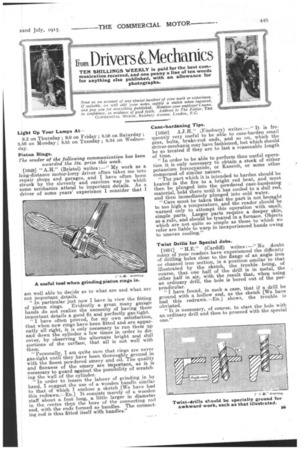Kom Drivers &Mechanics
Page 21

If you've noticed an error in this article please click here to report it so we can fix it.
TEN SHILLINGS WEEKLY is paid for the best communication received, and one penny a line of ten words for anything else published, with an allowance for photographs.
Send us an account of any sPeeial incident of your work or experience. If suitable, we will edit your notes, supPly a sketch when required, and pay you for everything published. Mention your employer's name, in confidence, as evidence of good faith, Address to The Editor, THE COMMERCIAL MOTOR, Rosebery Avenue, London, E.G.
Light Up Your Lamps At 9.2 on Thursday ; 9.0 on Friday ; 8.59 on Saturday ; 8.56 on Monday ; 8.55 on Tuesday ; 8.54 on Wednesday.
Piston Rings.
l'he sender of the following communication has been a warded the 10s. prize this week.
[1649] " A.H." (Bristol) writes :—" My work as a long-distance motor-lorry driver often takes me into repair shops and garages, and I have often been struck' by the slovenly and careless way in which some mechanics attend to important details. As a driver of some years' experience I consider that I
am well able to decide as to what are and what are not important details.
"In particular just now I have in view the fitting of piston rings. Evidently a great many garage hands do not realize the necessity of having these important details a good fit and perfectly gas-tight. I have often proved, for my own satisfaction, that when new rings have been fitted and are apparently all right, it is only necessary to run them up and down the cylinder a few times in order to discover, by observing the alternate bright and dull portions of the surface, that all is not well with them.
"Personally, I am quite sure that rings are never gas-tight until they have been thoroughly ground in with the finest powdered emery and oil. The quality and fineness of the emery are important, as it is necessary to guard against the possibility of scratch ing the wall of the cylinder. "In order to lessen the labour of grinding in by hand, I suggest the use of a. wooden handle similar to that of which I enclose a. sketch [We have had this redrawn.—En.] It consists merely of a wooden staff about a foot long, a little larger in diameter in the centre than the bore of the connecting rod end, with the ends formed as handles. The connecting rod is thus fitted itself with handles."
Case-hardening Tips.
[1650] A.J.H." \'Finsbury) writes :—" It is frequently very useful to be able to ease-harden small pins, bolts, brake-rod ends, and so on, which the driver-mechanic may have fashioned, but which should be so treated if they are to last a reasonable length of time.
"In order to be able to perform thus useful operation it is only necessary to obtain a, stock of either potassium ferrocyanide, or Kasenit, or some other compound of similar nature. "The part which it is intended to harden should be heated in the fire to a bright red heat, and must then be plunged into the powdered case-hardening material, held there until it has cooled to a dull red, and then immediately plunged into cold water. "Care must be taken that the part is not brought to too high a temperature, and the reader should be warned only to attempt this operation with small, simple parts. Larger parts require a deeper skin, as a, rule, and should be treated in a furnace. Objects which are not quite so simple as those to which we refer are liable to warp in inexperienced hands owing to uneven cooling."
Twist Drills for Special Jobs.
[1651] " H.E." (Cardiff) writes :—" No doubt many of your readers have experienced the difficulty of drilling holes close to the flange of an angle iron or channel iron section, in a position similar to that illustrated by the sketch, the trouble being, of course, that one half of the drill is in metal, the other half in air, with the result that, when using an ordinary drill, the hole is bored out of the perpendicular. "I have found, in such a case, that if a drill be ground with a hollow end, as the sketch [We have had this redrawn.—En.] shows, the trouble is obviated.
• "It is necessary, of course, to start the hole with an ordinary drill and then to proceed with the special one."






















